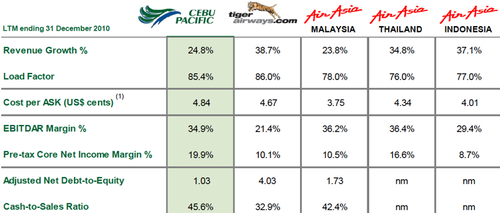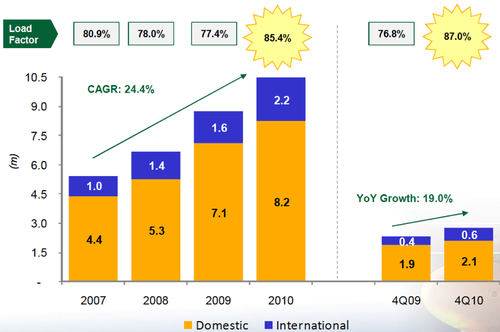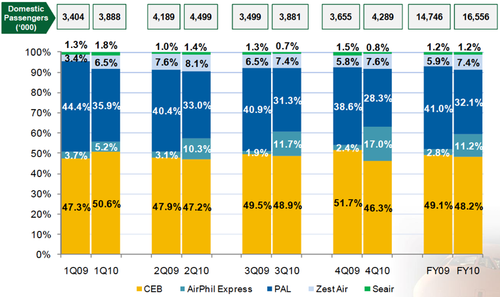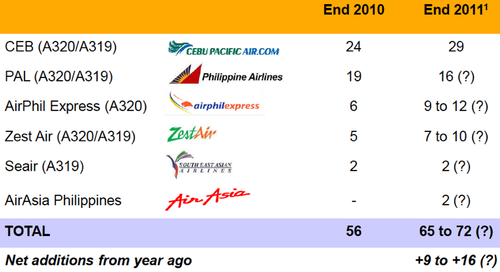Cebu Pacific on track for 12 million pax in 2011 following 12% growth in 1Q
Cebu Pacific stated it handled more than 2.8 million passengers in 1Q2011, marking growth of 12% year-on-year increase. Load factors averaged 87% for a 4ppt improvement. This result keeps the airline on track to achieving its 12 million-passenger target this year, which would be a 15% increase from the 10.46 million passengers handled in 2010.
- Cebu Pacific experienced a 12% year-on-year increase in passenger numbers in 1Q2011, handling over 2.8 million passengers.
- The airline achieved an average load factor of 87% in the quarter, a 4ppt improvement from the previous year.
- Cebu Pacific's growth was driven by international traffic, which saw a 32% increase in passengers compared to the same period last year.
- The airline plans to expand its operations in North Asia, with a focus on Greater China, Taiwan, Japan, and South Korea.
- Cebu Pacific aims to increase its fleet size to 37 aircraft by the end of 2011, with an average age of 3.5 years.
- The airline will face increased competition from foreign carriers entering the Philippines market, including AirAsia, Tiger Airways, and Jetstar.
Cebu Pacific's load factors in the quarter were higher than AirAsia's, which stood at 80% for Malaysia AirAsia, 84% for Thai AirAsia and 79% for Indonesia AirAsia. Tiger Airways' Mar-2011 load factor was also lower, at 85%. In 2010, Cebu Pacific stated its load factors were higher than AirAsia load factors, but slightly lower than Tiger Airways.
Asian LCC benchmarks
Cebu Pacific attributed the growth in the first quarter to its "trademark low fares, the increasing number of passengers who avail of our affordable seat sales months in advance, and our extensive route network". According to its website, Cebu Pacific has offered seven separate advertised seat sales in Apr-2011, 11 in Mar-2011, nine in Feb-2011 and eight in Jan-2011.
The carrier's first quarter growth was predominantly driven by international traffic, which increased 32% year-on-year to 672,456 passengers. This occurred as flight frequency increased to key international markets, brought about by the additional capacity from the carrier's new A320. The airline doubled its Manila-Incheon (Seoul) services, making it twice daily from Jan-2011. It also added three times weekly Manila-Bangkok service, for a 10 times weekly service from Feb-2011.
Meanwhile, the carrier broke a new company record for the most number of passengers flown in one day on 30-Mar-2011. A total 36,949 passengers travelled with Cebu Pacific on the day, beating previous highlights of 36,893 passengers on 28-Mar-2011 and 34,871 passengers on 02-Jan-2011.
Cebu Pacific bullish about North Asia expansion on 1Q growth
Cebu Pacific separately stated it remains optimistic about expansion in North Asia, especially with a passenger growth of 28% for its Greater China, Taiwan, Japan and South Korea routes in 1Q2011.
The carrier handled 381,513 passengers between North Asia and the Philippines in 1Q2011, compared with 298,485 passengers in 1Q2010. During the quarter, the carrier witnessed passenger growth of 73% in Taiwan, 30% in Japan, 31% in South Korea and 23% in Greater China, compared with the same period last year. The carrier operates 73 weekly services to Greater China, seven weekly services to Taipei, three times weekly to Osaka and 18 times weekly to South Korea.
The carrier also plans to launch four times weekly Manila-Busan service on 15-Jun-2011 and has applied to operate to Nagoya and Tokyo in the near future. The carrier also plans to increase flights to Beijing and Guangzhou to accommodate passenger demand
Operating 13.9 block hours with 8.2 turns per day
In 2010, Cebu Pacific operated 13.9 block hours per day with 8.2 turns per day. The carrier reported traffic growth of 19.5% with an average load factor of 85.4%, international traffic growth of 37.9% and had a 51.6% domestic cargo market share. According to data released by the Philippines Civil Aeronautica Board in Apr-2011, Cebu Pacific handled 2.1 million international passengers in 2010, for growth of 26.4%, behind Philippine Airlines with 3.9 million passengers (+14.7%).
Cebu Pacific traffic growth: 2010
Cebu Pacific international air traffic growth
Cebu Pacific was the Philippines' largest domestic carrier, with 48.2% market share in FY2010.
Domestic market leadership
Continued fleet growth ahead
Cebu Pacific, which operates the most number of routes and flights in the Philippines, took delivery of its 15th A320 in Jan-2011, increasing the airline's fleet size to 33 aircraft. The carrier's fleet is composed of 10 A319s, 15 A320s and eight ATR-72 500 aircraft. By the end of 2011, the LCC will be operating a fleet of 37 aircraft - with an average age of 3.5 years. Between 2012 and 2014, Cebu Pacific will take an additional 16 A320 aircraft.
Four brand new A320 aircraft were delivered from Oct-2010 to Jan- 2011, all financed through ECA-supported loans. The carrier has also advanced to 2011 the delivery of two A320 aircraft which were originally scheduled for delivery in 2012 under operating leases.
Cebu Pacific fleet expansion plan: 2009 to 2014
According to estimates made by Cebu Pacific in Mar-2011, the carrier operate up to 45% of the A320 fleet of Philppine carriers by the end of 2011, up from 43% in 2010.
Estimated A320-family fleet plans of Philippine carriers
Estimates made by Cebu Pacific based on industry sources and press releases of local carriers
Increased competition from foreign carriers
Despite its dominant position in the domestic market at present, Cebu Pacific will face increased competition from foreign carriers in the Philippines market in 2011.
AirAsia plans to establish a JV in the Philippines which is targetted to start operations in 3Q11. The Philippine joint venture will operate out of Clark in Pampanga initially with two A320 aircraft. AirAsia has been operating in the Philippines since 2005, with one daily services between Kuala Lumpur and Clark, and one daily services between Kota Kinabalu and Clark.
Meanwhile, Tiger Airways and Philippine carrier Seair have established a "Partner Airline" programme. Seair is operating Singapore flights to/from Clark flights using two 144-seater A319 aircraft leased from Tiger. Seair's seats and ancillary services for this route will be sold through Tiger's website. Tiger recently took 32.5% stake in Seair.
Jetstar has also stated it is in talks with various local companies, looking for a Filipino partner. It also wants to tap markets outside Manila such as Cebu and Aklan.
Meanwhile, the Philippine Government, on 14-Mar-2011, issued EO 29 (Pocket Open Skies) which aims to boost tourism and foreign investments into the Philippines. A main provision of EO 29 authorises the Philippine Air Panels to promote and the Civil Aeronautics Board to grant unrestricted third, fourth and fifth freedom rights to the country's airports other than the NAIA.
Cebu Pacific CEO Lance Gokongwei recommended that reciprocity be an integral requirement under the rules and regulations that will be prepared to implement Executive Order 29. Mr Gokongwei stated, "We would like to be part of this competition. If foreign carriers are given unlimited access on routes to and from the Philippines, we believe it is only fair that Cebu Pacific and other local airlines be given unlimited access to and from the Philippines to these carriers' home countries, on an equal opportunity of access, on a level playing field."
Rising fuel costs also a challenge
Another challenge for Cebu Pacific is rising fuel costs although the carrier stated it is aiming to come out of this fuel crisis stronger as it has done so in FY2008.
Fuel accounted for approximately 43% of Cebu Pacific's operating cost in FY2010. The carrier has hedged 30-35% of fuel requirements up to end FY2011. The carrier however noted that the peso appreciation can offset increases in jet fuel price.
The carrier is also planning to reduce its non-fuel unit cost with the addition of A320s and economies of scale from additional frequencies. The carrier is also growing its ancillary revenue streams, by unbundling more services, increasing rates and increasing conversion. The carrier is also reintroducing a fuel surcharge, initially on international routes. Cebu Pacific's ancillary revenues increased 10.1% year-on-year to USD54.6 million in 2010, to represent 8% of the carrier's total revenues.





